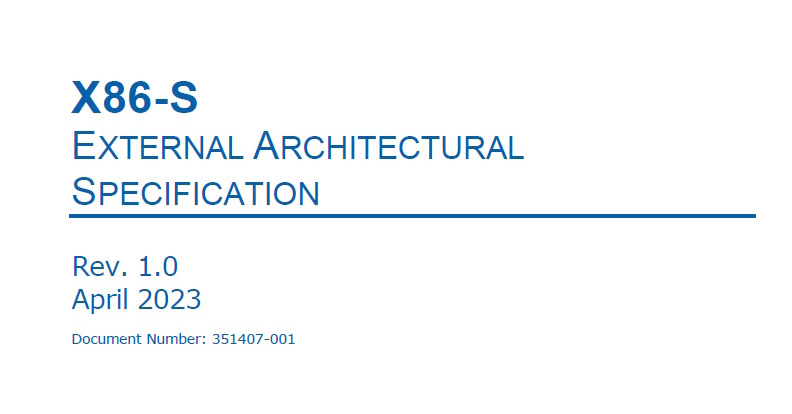Intel announces new CPU architectureX86-SFirst release (revision 1.0) of the specificationpublished.In order to promote the simplification of both hardware and software (mainly UEFI and OS), this architectureDelete jobs running in 16-bit / 32-bitand it runs in 64-bit mode from the start when the power is turned on.
In the future, the company has indicated a policy for migrating CPUs to the X86-S architecture, and is asking for opinions on this architecture (spec).
The first release of the “X86-S External Architectural Specification” published by Intel (PDF format)
X86-S Overview
In 2004, Intel first released an x86 CPU that supported 64-bit instructions (x64 / Intel 64) (reference article). Since then, the lineup of CPUs that support 64-bit instructions has been expanded, and there is no current x86 CPU that does not support 64-bit instructions.
In 2005, “Windows XP x64 Edition”, which supports 64-bit instructions, was launched as the main operating system for general computers. Since then, Windows has been released in two versions, 32-bit and 64-bit, but with the release of “Windows 11” in 2021, the 32-bit version has finally been “discontinued”.
All current x86 CPUs support 64-bit instructions. And the latest version of Windows, Windows 11, was only released as a 64-bit version.
On the other hand, existing x86 CPUs continue to support 16-bit/32-bit instructions from the perspective of ensuring compatibility with previous x86 architecture operating systems and applications. 16-bit instructions have been around for about 45 years since the “8086 processor”, the root of the x86 architecture, and 32-bit instructions have “survived” for about 38 years since the “80386 processor”.
Strictly speaking, CPUs that support 64-bit instructions in 2004 and later do not support “virtualization 86 (VM386)”, and CPUs released after 2008 do not have “A20 gates”. Therefore, in principle, operating systems and applications that depend on it will not function without an emulator.
In addition, the various firmwares provided by Intel after 2020 do not support 16-bit/32-bit booting, nor do they support operating systems that cannot boot with UEFI (≈ can only boot with BIOS or CSM).
Rough history of x86 architecture (since it is Intel’s view of history, x86 CPUs of other companies such as AMD are not mentioned). In timing support for 64-bit instructions, “86 virtualization” (a function that achieves multitasking by pretending to have multiple 8086 processors) is not supported, and CPUs released after 2008 use the “A20 gate (a function that enhances compatibility with 8086/80186). ) “Not Installed
In this way, it took nearly 20 years, but the computer64-bit onlyHowever, the environment is set up not to be a problem. And support for 16-bit/32-bit instructions on x86 processors became “unnecessary”.
There is also an improvement in the performance of the CPU itself, and if you run an operating system or application that requires a 16-bit / 32-bit CPU (or legacy BIOS), you can basically manage it through an emulator.
Therefore, in the X86-S architecture, the mode in which the CPU operates in 16-bit / 32-bit mode is omitted. for this reason,Works in 64-bit mode from the moment the power is turned on (reset)。
Traditionally, immediately after power-on (reset), an x86 CPU runs in 16-bit mode, then switches to 32-bit mode and then to 64-bit mode, or from 16-bit mode to 64-bit mode.
Since the X86-S architecture does not require this mode switching,Simplified CPU structure and instructions. It also makes it easier to focus on improving pure CPU performance.
Existing 64-bit x86 CPU runs in 16-bit mode when power on (on reset), then switches to 64-bit mode. The X86-S architecture has been modified to run in 64-bit mode from the moment the power is turned on.
In addition, the X86-S architecture is expected to undergo the following major specification changes.
- Use a simplified 64-bit partial model to partially support 32-bit applications
- Removed ring protection (ring 1/ring 2), which is rarely used in modern applications, and legacy hashing features such as “gates”
- 16-bit addressing functionality has been removed
- I/O ports access revoked with ring protection (ring 3)
- Cancel chain port I/O based on CPU I/O model
- When using APIC (interrupt controller) specify it with “X2APIC” (discontinued for Intel 8259)
- Remove obsolete OS mode bits
Major (planned) changes to the X86-S architecture. Details can be found in the published specifications.
Related articles
Related links
Copyright © ITmedia, Inc. All Rights Reserved. all rights are save.

“Travel maven. Beer expert. Subtly charming alcohol fan. Internet junkie. Avid bacon scholar.”






More Stories
Shimaru Building Musical Terrace|Event|Pick Up Today|Marunouchi.com
“iPhone14 Pro” vs. “High-end Compact Digital Camera”.Comparison of photos taken in the mountains |. LifehackerJapan
Ubuntu 24.04 LTS – PC Watch